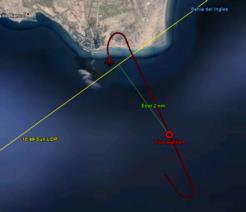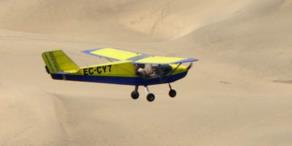
NavList:
A Community Devoted to the Preservation and Practice of Celestial Navigation and Other Methods of Traditional Wayfinding
Fw: My First airborne shots
From: Gary LaPook
Date: 2014 Jan 1, 01:36 -0800
From: Gary LaPook
Date: 2014 Jan 1, 01:36 -0800
Very impressive. Did you have someone else flying the plane or did you have to do that yourself while taking the shots? How long a period did you use for the averaging? Flying toward the Sun eliminates the coriolis error since it varies with the relative bearing, becoming maximum when the relative bearing is 90°, the object being on the wingtip and zero when the object is on the nose. The formula for this correction is, coriolis correction in minutes of arc is equal to .0262 times the ground speed in knots times the sine of the latitude times the sine of the relative bearing. At 80 mph (70 knots) the maximum coriolis correction is 1.8' but that would be for an object on the wingtip while you were flying over the north pole (latitude = 90°, sine = 1.0). At your latitude and ground speed the maximum coriolis correction
is only 0.9' for an object out on the wingtip.
The precomputation serves two purposes, it allows you to draw the LOP quickly after taking the shot and it helps you find the celestial object in the field of view by using the precomputed altitude to set your sextant and the precomputed azimuth to aim a periscopic sextant. This is especially important when shooting stars with a periscopic sextant because you can't see the pattern of the constellations in the limited field of view. It is easy to find the sun in the field of view so the precomputation is not necessary unless you are going to plot the LOP while in
flight but is not necessary if you are just going to analyze your shots after you are on the ground.
The speed setting on the Polhemus computer only affects the "Motion Of the Observer" correction and the coriolis correction. The MOO correction may or may not be relevant depending on what method you use for sight reduction. Since both the MOO and he coriolis correction windows work by multiplication you can get the correction for 70 knots by setting the speed to 700 knots and then simply dividing the displayed corrections by 10.
gl
gl
----- Forwarded Message -----
From: Eric van der Veen <ericvdveen@tiscali.nl>
To: garylapook@pacbell.net
Sent: Sunday, December 29, 2013 12:10 PM
Subject: [NavList] My First airborne shots
From: Eric van der Veen <ericvdveen@tiscali.nl>
To: garylapook@pacbell.net
Sent: Sunday, December 29, 2013 12:10 PM
Subject: [NavList] My First airborne shots
Insofar the ambition of navlist is to '..preserve..' , consider this might at least a minor success. I have started CelNav only 2 years ago, and took my first airborne sightings last week.
Thanks to all the clarifying posts by Greg and Gary and others, these greatly helped me. A brief report:
Flying from Canary Islands (27d47 N, 15d30 W) in a RANS Coyote microlight (i.e. a Light Sports Aircraft, very wobbly indeed) using my Mk. IX sextant. On SSE course, repeated runs towards the sun at between 1000 and 1100 UTC. Sun and moon both in the 20-25 degree altitude range, but the moon too weak for a good sight. Thus only Sun LOPs taken.
Best shot: distance from actual (GPS-) position to LOP was 1.9 nm. That was satisfying.
I did not do pre-computation because I am still in the process of figuring that out.. Also, the Polhemus is of limited use because
this aircraft's speed at 80 mph falls below the minimum value of the Polhemus at 90 kts.
Any comments, suggestions, questions welcome.
Eric
----------------------------------------------------------------
NavList message boards and member settings: www.fer3.com/NavList
Members may optionally receive posts by email.
To cancel email delivery, send a message to NoMail[at]fer3.com
----------------------------------------------------------------
Attached File:

(Shot-2a.png: Open and save)
Attached File:

(Coyote.jpg: Open and save)
Eric
----------------------------------------------------------------
NavList message boards and member settings: www.fer3.com/NavList
Members may optionally receive posts by email.
To cancel email delivery, send a message to NoMail[at]fer3.com
----------------------------------------------------------------
Attached File:

(Shot-2a.png: Open and save)
Attached File:

(Coyote.jpg: Open and save)
: http://fer3.com/arc/m2.aspx?i=126024






